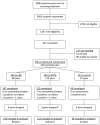The impact of focusing a program to prevent heavier drinking on a pre-existing phenotype, the low level of response to alcohol
- PMID: 25656349
- PMCID: PMC4331238
- DOI: 10.1111/acer.12620
The impact of focusing a program to prevent heavier drinking on a pre-existing phenotype, the low level of response to alcohol
Abstract
Background: Heavy drinking is common during transitions from high school to college. Optimal programs for diminishing risks for high alcohol consumption often tailor the approach to the specific needs of students. This study describes the results of an Internet-based prevention protocol that tailors the information to the risk associated with a pre-existing phenotype, the Low level of Response (Low LR) to alcohol.
Methods: Using stratified random assignment, 454 freshmen with Low and High LR values were assigned to 2 education groups (LR-based where all examples were given the context of the Low LR model of heavy drinking or a State Of The Art (SOTA) Group where the same lessons were taught but without an emphasis on LR) or a no-intervention Control Group. Individuals in the 2 education groups viewed 50-minute online videos once per week for 4 weeks. Changes in drinking patterns were assessed at Baseline, 4 weeks, and 8 weeks using a 2 (LR status) by 3 (education group) by 3 (time points) analysis of variance, with additional tests for ethnicity and sex.
Results: Low LR participants tended to decrease their usual (p < 0.06) and maximum (p < 0.05) drinks per occasion most prominently when assigned to the LR-based protocol, while those with High LRs improved more in the SOTA Group. The most robust differences were seen when controlling for ethnicity. The effect sizes were small to medium.
Conclusions: These results support the advantages of carrying out prevention via the Internet and in tailoring the approach to a pre-existing phenotype.
Keywords: Alcohol; Internet; Level of Response; Prevention.
Copyright © 2015 by the Research Society on Alcoholism.
Figures





References
-
- American Psychiatric Association. Fourth diagnostic and statistical manual. APA Press; Washington DC: 1994.
-
- Bucholz KK, Cadoret R, Cloninger CR, Dinwiddie SH, Hesselbrock VM, Nurnberger JI, Jr, Reich T, Schmidt I, Schuckit MA. A new, semi-structured psychiatric interview for use in genetic linkage studies: a report on the reliability of the SSAGA. J Stud Alcohol. 1994;55:149–158. - PubMed
Publication types
MeSH terms
Grants and funding
LinkOut - more resources
Full Text Sources
Other Literature Sources
Medical

